Today, let’s step into the enchanting realm of Lake Okeechobee, a lake tucked away in the scenic landscapes of Florida. Spanning a massive area of about 730 square miles, this remarkable freshwater lake is worth exploring and getting to know, thanks to its serene beauty and fascinating past. Fondly called the “Big O,” this lake has been witness to the captivating stories of Native American tribes, played a crucial role in Florida’s growth, and provided a safe haven for a diverse array of wildlife.
This article will explore and cover every aspect of Lake Okeechobee. We’ll discuss the lake’s history, geology, fishing, and many other fascinating details! Let’s dive in.
Location
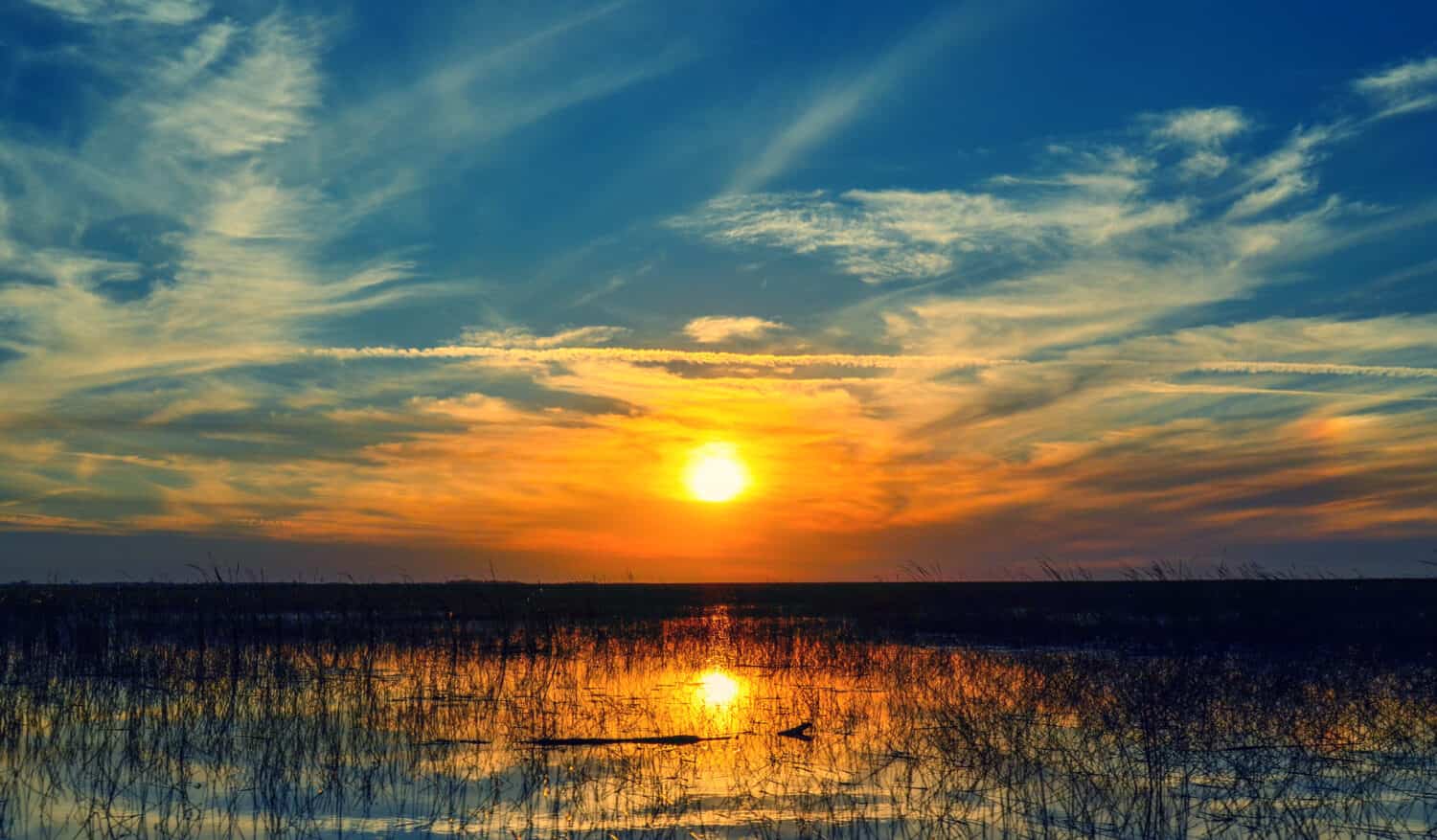
Marking the northern boundary of the Everglades, Lake Okeechobee is found in southeastern Florida.
©JMP_Traveler/Shutterstock.com
Lake Okeechobee is a freshwater lake in southeastern Florida, United States. Nestled approximately 40 miles northwest of the vibrant city of West Palm Beach, this water body marks the northern boundary of the renowned Everglades.
Lake Okeechobee is shared among Okeechobee, Palm Beach, Glades, Martin, and Hendry counties. These five counties intersect at a central point near the center of the lake.
History

With a fascinating history that goes back centuries, Lake Okeechobee has been known by many names over the years.
©Norm Lane/Shutterstock.com
Lake Okeechobee has a fascinating history that dates back centuries. The earliest known inhabitants, the Calusa people, referred to the lake as Mayaimi, meaning “big water.” This name reflects the lake’s immense size and importance. In the 16th century, the name Okeechobee emerged from the Hitchiti language, combining the words “oki” (water) and “chubi” (big).
During this period, explorers like René Goulaine de Laudonnière learned about a large freshwater lake in southern Florida called Serrope. The lake was initially considered somewhat mythical. British mapmakers and chroniclers of the 18th century referred to it as Laguna de Espiritu Santo, based on Spanish accounts. It was also known as Mayacco Lake or Lake Mayaca in the early 19th century, named after the Mayaca people who settled near the lake.
Lake Okeechobee holds a significant place in history due to the momentous Battle of Lake Okeechobee. In December 1837, General Zachary Taylor led approximately 1,000 U.S. troops against an estimated 400 Seminole warriors. The battle lasted three hours and resulted in the collapse of the warriors’ defense. The battle only provided a tactical win for the U.S. forces and did not decisively end the conflict.
Lake Okeechobee’s geographical boundaries were initially encompassed by Palm Beach County when it was established in 1909. However, in 1963, the lake’s jurisdiction was divided among the five counties that surround it.
The lake’s history reflects the cultural heritage of the indigenous people, early explorers, and the impact of conflicts in the region. Understanding the lake’s past helps us appreciate its significance and the diverse stories it holds.
Size
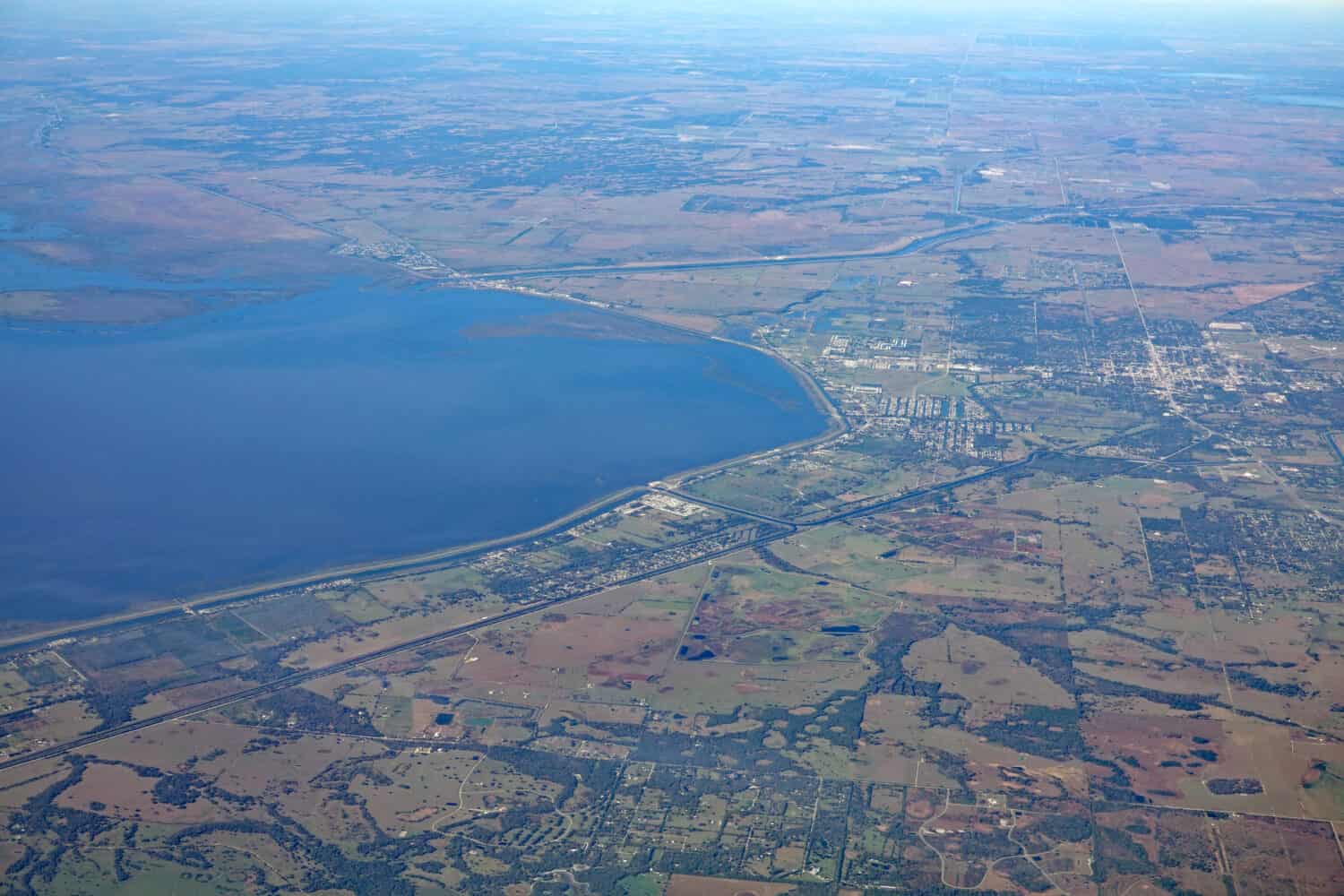
The second largest freshwater lake in the contiguous US, Lake Okeechobee is 36 miles long and has a maximum depth of 13 feet.
©Thomas Barrat/Shutterstock.com
Lake Okeechobee is the second-largest freshwater lake in the entire contiguous United States. And it also holds the distinction of being the largest lake in the state of Florida. This lake stretches an impressive 36 miles in length and boasts a maximum width of 29 miles.
The lake has a vast surface area of 734 square miles and a picturesque shoreline that spans approximately 135 miles. Lake Okeechobee is also adorned with many small islands and is often referred to as Florida’s Inland Sea. Lake Okeechobee receives over 60% of its water from the Kissimmee River, making it the primary contributor.
Depth
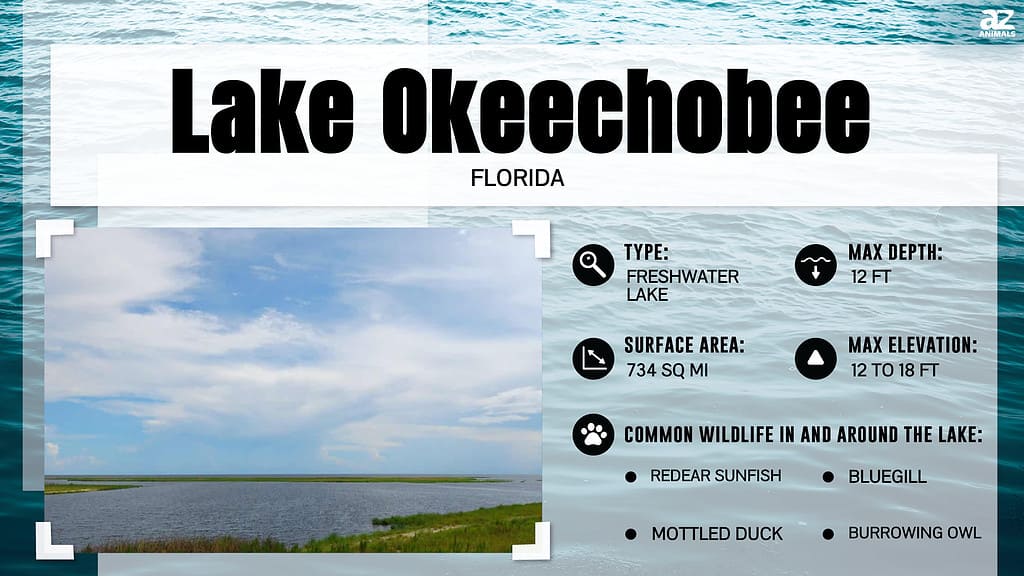
Lake Okeechobee’s depth sets it apart, as it is remarkably shallow considering its size. The lake has an average depth of just 9 feet and a maximum depth of 13 feet.
Water Level
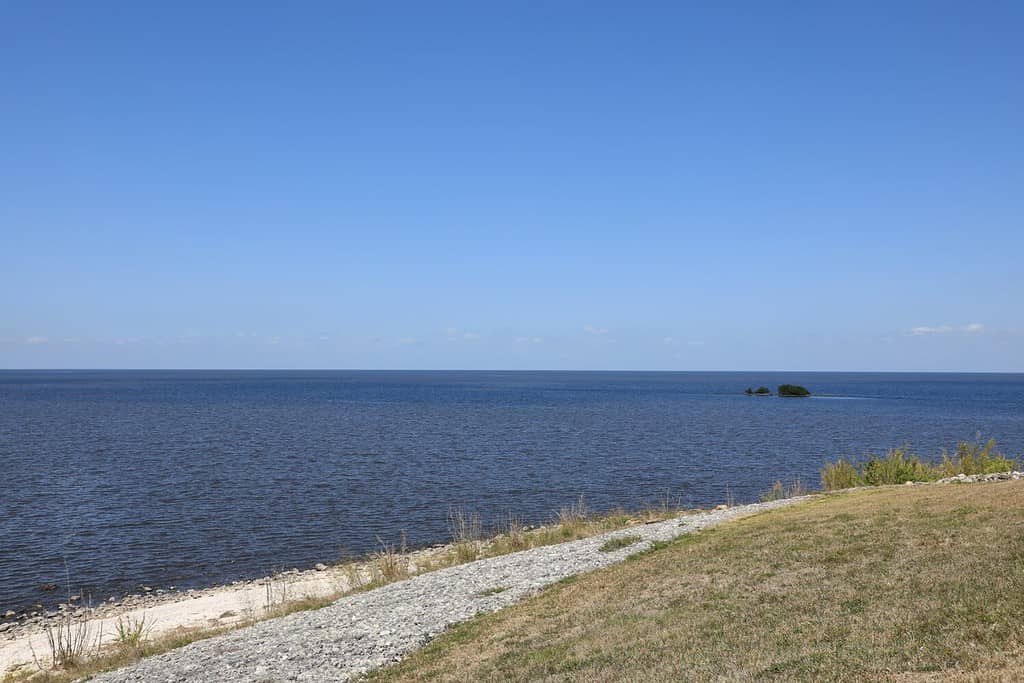
Lake Okeechobee’s water level depends on the season and the amount of rainfall, generally ranging from 11 to 15 feet.
©Thomas Barrat/Shutterstock.com
The water levels of Lake Okeechobee solely depend on the rainfall. As expected, when rain showers bless the area, the water levels rise. Conversely, during drier spells, the water gradually recedes, revealing a different side of the lake’s charm.
The average water levels range from 12 to 15 feet above sea level. However, during the summer, the water level generally falls between 11 to 14 feet above sea level. In some cases, the level can fall even lower.
Geology
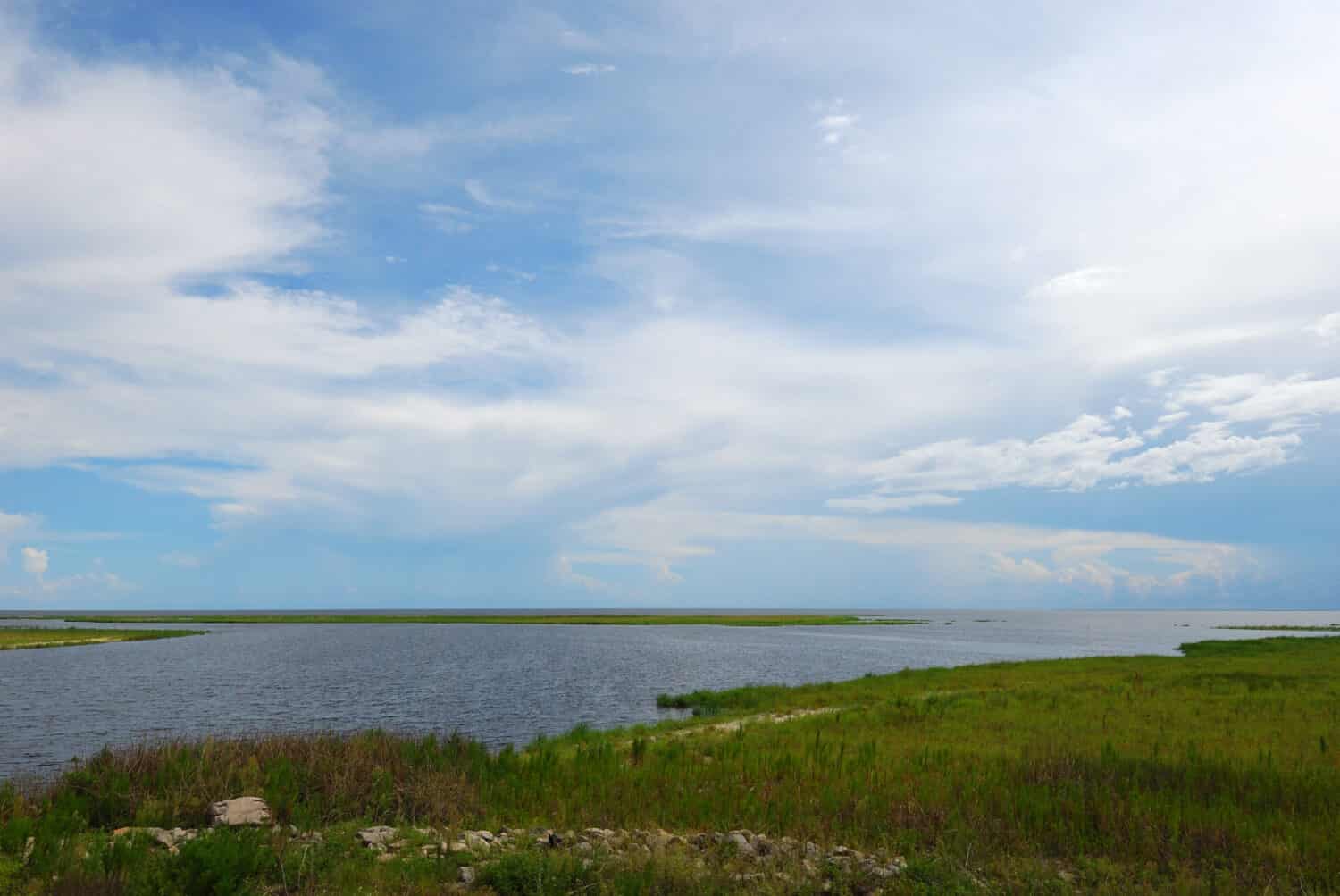
Once upon a time, the trough used to be dry land just 6,000 years ago.
©Jose Antonio Perez/Shutterstock.com
Lake Okeechobee occupies a special geological basin that extends beneath both the Everglades and the Kissimmee River Valley. Unlike the limestone and sand deposits along Florida’s coastlines, this trough is predominantly composed of compacted clay deposits.
Surprisingly, this very trough was once dry land, dating back approximately 6,000 years ago. As the sea level gradually rose, Florida’s water table followed suit, accompanied by increased rainfall. A transformation began, and from 6,000 to 4,000 years ago, vibrant wetlands took shape, with peat deposits accumulating gradually.
Over time, the continuous flow of water resulted in the formation of an expansive lake, submerging the previously flourishing lands beneath its surface.
The depths of Lake Okeechobee conceal a fascinating limestone basin. And the lake’s waters carry a touch of murkiness due to runoff from the surrounding farmlands. Nevertheless, this unique geological makeup and its intriguing history add to the charm of Lake Okeechobee, painting a vivid picture of its natural wonders.
Fishing
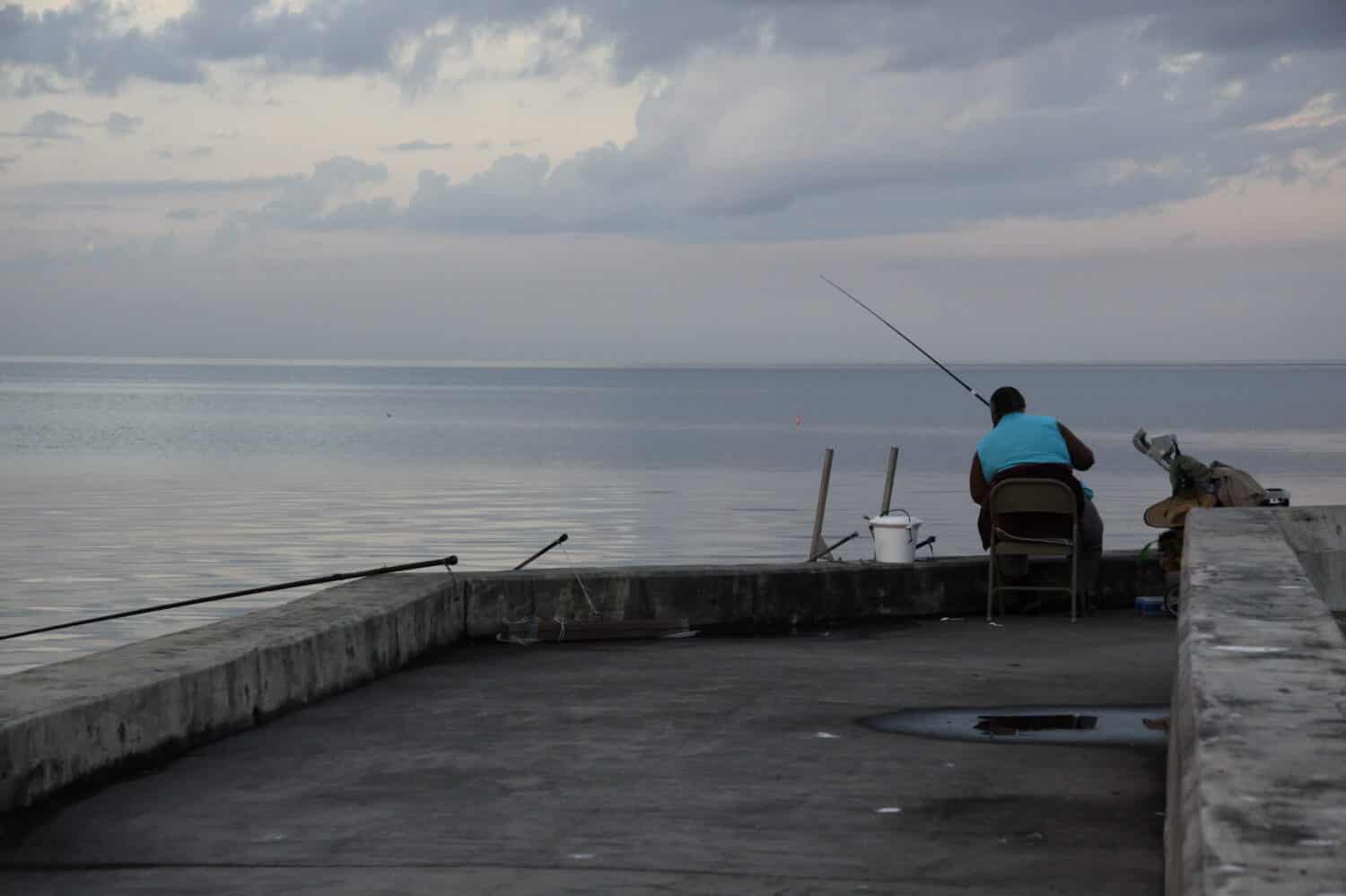
With multiple marinas, boat rental services, and 135 miles of shoreline, there are plenty of opportunities to fish in Lake Okeechobee.
©Berezovskaya/Shutterstock.com
Lake Okeechobee offers an abundance of fishing opportunities, amplified by the presence of surrounding canals and rivers.
Throughout the year, numerous major fishing tournaments take place on the lake, but the joy of angling is a year-round affair here. Whether you like exploring independently or prefer a guided adventure, fishing at Lake Okeechobee is an unbeatable experience. Just remember to bring your fishing gear!
Largemouth bass fishing is a primary draw for anglers, with the prospect of catching big bass fueling excitement. Moreover, Lake Okeechobee is also home to bluegill, pickerel, crappie, bowfin, catfish, gar, and sunfish. With an extensive shoreline stretching for 135 miles, you’ll find no shortage of perfect spots to cast your line and immerse yourself in the fishing experience.
There are multiple marinas available, ensuring easy access to the lake. Furthermore, boat rental services allow you to embark on your fishing adventure hassle-free, and numerous boat launch ramps make it convenient to set sail.
Campgrounds with RV hookups offer comfortable accommodations for those seeking to extend their stay around the lake. You’ll also find various lodging options, along with convenience stores, bait and tackle shops, and even restaurants, to fulfill all your needs during your time at Lake Okeechobee.
Boating
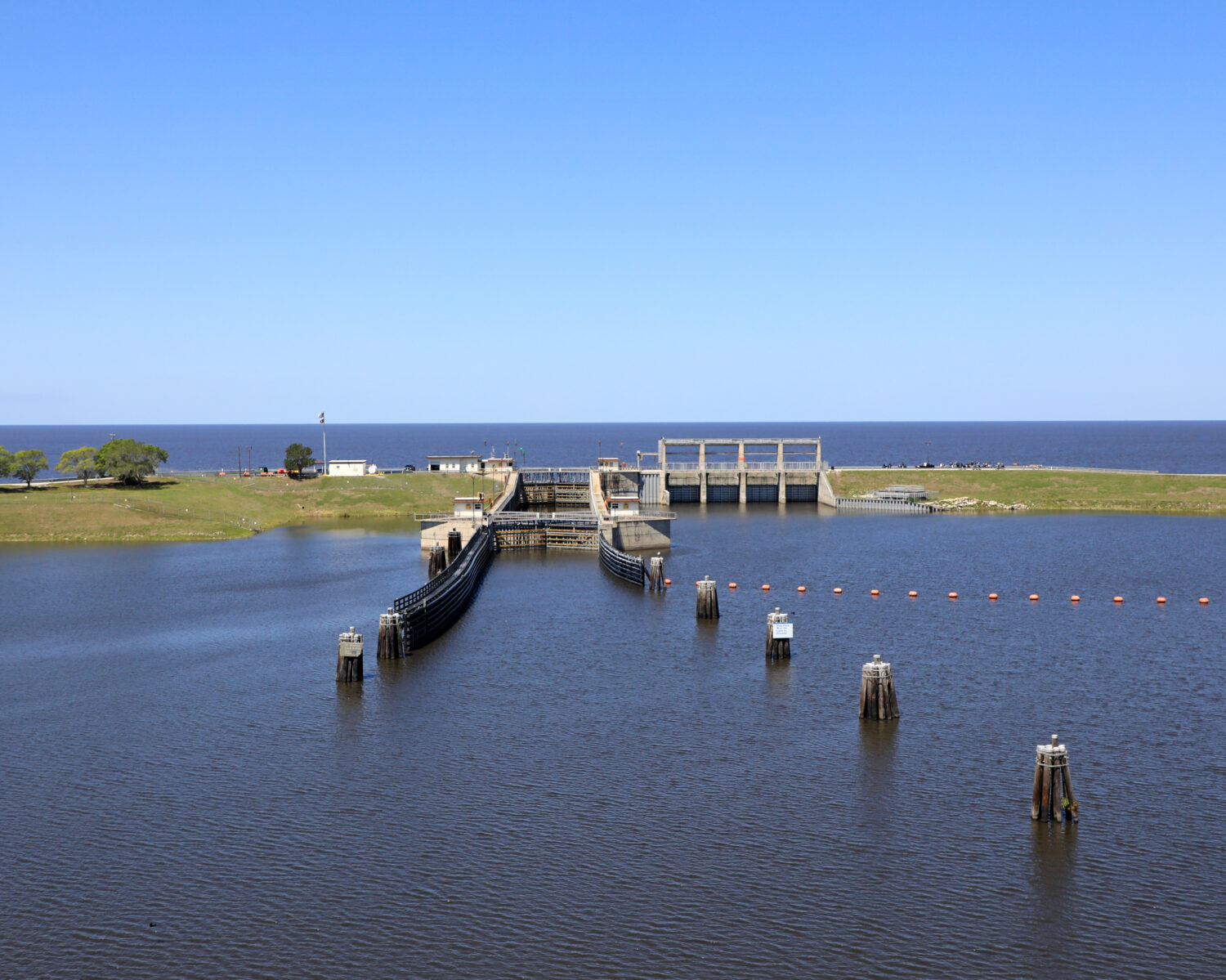
Lake Okeechobee has seven marinas and thirteen boat ramps around its shores.
©Thomas Barrat/Shutterstock.com
With seven marinas dotting its shores, Lake Okeechobee ensures easy access and convenience for boaters. These marinas, including popular ones like Roland Martin Marina and Okee-Tantie Marina, provide boat rentals, fuel stations, and expert guidance, catering to both seasoned captains and novice sailors.
For launching your own vessel, Lake Okeechobee boasts thirteen well-maintained boat ramps strategically placed around its perimeter. These ramps, such as the Scott Driver Boat Ramp and Harney Pond Canal Boat Ramp, offer seamless entry into the water, ensuring a smooth and hassle-free boating experience.
As you navigate the lake, you’ll encounter five islands, each with its own unique charm. Ritta Island and Kreamer Island are just a couple of the idyllic spots where you can anchor, explore, and bask in the tranquility of nature.
Two bridges, including the Port Mayaca Lock and Dam Bridge, span across the lake, providing scenic views and adding to the allure of your boating adventure.
Airboating

A popular activity in Lake Okeechobee is airboating.
©SuJo Studios/Shutterstock.com
Airboating, a popular activity in the area, offers an exciting way to explore Lake Okeechobee. These unique vessels, equipped with aircraft-type propellers and powerful engines, are perfect for navigating the shallow waters and grass-filled trails that surround the lake.
When it comes to exploring marshy or shallow waterways, airboats outshine standard boats with their flat-bottomed design and propellers that excel in these environments. There are no moving underwater parts in an airboat, which enhances safety for both the fish and plants in the surrounding environment.
They are specifically crafted to tackle the challenges of Lake Okeechobee’s vibrant ecosystem, where submerged propellers struggle to perform.
Duck Hunting
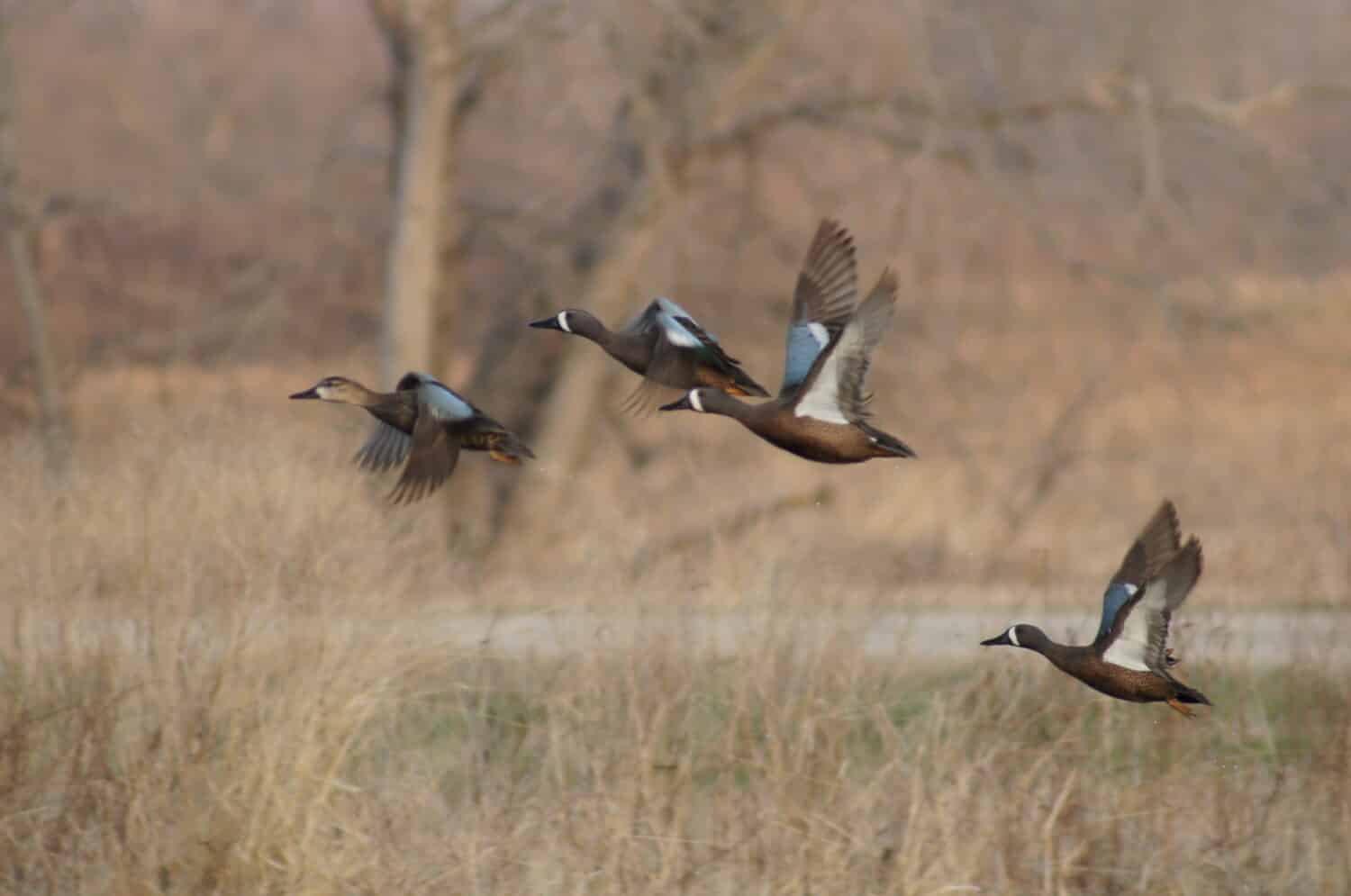
A favorite pastime in Lake Okeechobee is duck hunting.
©Steve Reule/Shutterstock.com
Experience the thrill of duck hunting at Lake Okeechobee, a haven for waterfowl during winter. This gem in Okeechobee County provides the ideal sanctuary for various duck species seeking feeding grounds and respite from their migratory journeys.
Lake Okeechobee’s allure for ducks lies in its exceptional conditions, boasting shallow waters, moist soil, and abundant food sources. These factors attract a myriad of ducks each year, making it one of the top destinations for duck hunting in Florida. Hunters from across the state and country flock to this renowned lake, drawn by the promise of an unforgettable waterfowl hunt.
To enhance your duck hunting experience, guided tours are readily available. These expert-led excursions offer valuable insights, local knowledge, and an increased chance of success. Duck species you can expect to find include the blue-winged teal, mottled duck, and ruddy duck.
Camping

There are plenty of campgrounds and RV parks surrounding Lake Okeechobee, allowing you to take advantage of your stay here.
©Jacob Lund/Shutterstock.com
The campgrounds in and around Lake Okeechobee are absolutely amazing! They surpass all expectations by combining thrilling outdoor adventures with convenient modern amenities. Whether you prefer a fully equipped campground with modern comforts or a simpler, back-to-basics retreat like Vantage Oaks Campground, Lake Okeechobee has something for everyone.
While most campgrounds provide conveniences like WiFi and cable TV, many are starting to recognize the value of unplugging and enjoying the simplicity of nature.
The campgrounds and RV parks of Okeechobee offer the opportunity to rejuvenate and create lasting memories. From shaded campsites to convenient boat-side parking, you’ll find everything you need for a relaxing getaway. Plus, you’re never too far from the amenities and conveniences of nearby Okeechobee town.
“R” camp, Flying Frog Ranch, and The Love Lodge are some of the best options for your next stay!
What makes camping at Lake Okeechobee truly special is the chance to connect with nature. The lake is a haven for bird lovers, offering glimpses of rare sightings like the captivating purple gallinule wading through the shallows. And if you’re lucky, you might even spot other fascinating creatures of the lake right outside your tent as the day begins.
The photo featured at the top of this post is © JMP_Traveler/Shutterstock.com
Thank you for reading! Have some feedback for us? Contact the AZ Animals editorial team.







